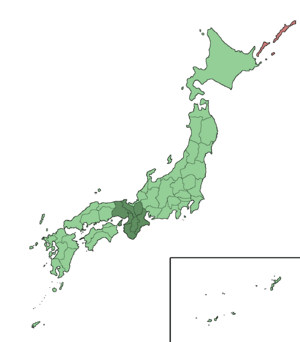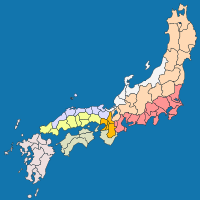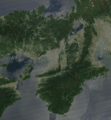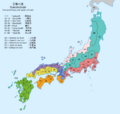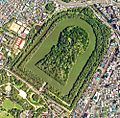Kansai region facts for kids
The Kansai region (関西地方, Kansai-chihō) is one of Japan's traditional regions The area is also known as the Kinki region (近畿地方, Kinki-chihō) or as the Kinai (畿内). The Japanese conventions of geography and history divide the nation into eight regions, including the Kansai region. These have been used since 1905 as basic units for description and comparison. and as cultural markers.
The regions of Japan are a fusion of historical divisions and modern administrative needs". The significance of the region in Japan is geographical, cultural and administrative.
Contents
History
In the late 7th century, the Kinki region were identified as one of the eight largest administrative areas of the Imperial system (ritsuryo seido).
Gokishichidō is an ancient system of names for parts of the country, including Kinki or Kansai. Kansai covers the area around the capital city of Kyoto on the island of Honshū in roughly the same area as the traditional Kinki.
In the Meiji period, the modern regional system was made by Imperial decree. Japan was divided into regions (chihō ), including the Kinki region. A regional council (chihō gyōsei kyōgisai) was headed by the governor of the most powerful prefecture in the regional grouping. The council also included regional chiefs of central government ministries.
Table: Kansai region
| Province | Province capital |  Pre-modern regions |
Prefecture | Prefecture capital |  Regions today |
Notes |
|---|---|---|---|---|---|---|
| Izumi | Kinai | Osaka | Osaka | Kansai | created in 716 from Kawachi, then rejoined back in 740, later re-split in 757 | |
| Kawachi | Kinai | Osaka | Osaka | Kansai | ||
| Settsu | Osaka | Kinai | Hyōgo; Osaka | Kobe; Osaka | Kansai | |
| Yamashiro | Kyoto | Kinai | Kyoto; Nara | Kyoto; Nara | Kansai | |
| Yamato | Wakigami | Kinai | Nara | Nara | Kansai | northern Nara without Yoshino |
Over time, Kansai has developed its own regional dialects, customs and unique traditional culture.
Related pages
Places named with Kansai
- Kansai Airport Station
- Kansai International Airport
- Kansai Ki-in (Organization for Go)
Images for kids
-
The Akashi Kaikyō Bridge, the longest suspension bridge in the world, with a centre span of 1,991 m
-
Daisen Kofun, the largest burial mound in the world
-
Hōryū-ji Golden Hall, the oldest wooden structure in the world
-
Izumo no Okuni, who founded Kabuki in Kyoto
-
Kongō Gumi, once the world's oldest continuously operating company, constructed several Japan's cultural assets.
-
Sen no Rikyū, a merchant from Sakai, perfected the courtesy of the tea ceremony.
-
Nintendo became the world's most successful video game company.
-
Kyoto from Kiyomizudera
See also
 In Spanish: Región de Kansai para niños
In Spanish: Región de Kansai para niños


